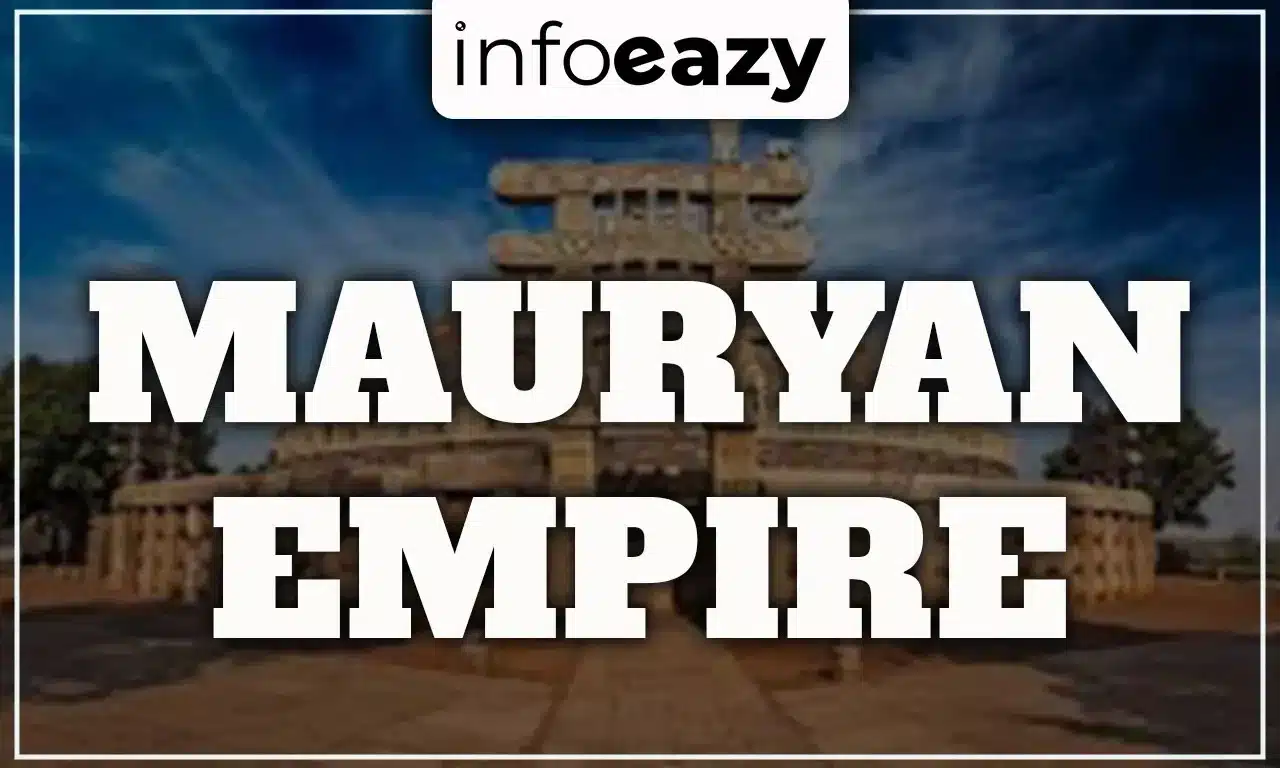The Mauryan Empire (322 BCE to 185 BCE) was the first large political empire of ancient India. Founded by Chandragupta Maurya under the guidance of Chanakya (Kautilya), it grew into one of the most powerful empires in world history. At its height, the Mauryan Empire covered almost the entire Indian subcontinent except for the extreme south. The capital was Pataliputra (modern Patna), which became a center of politics, culture, and administration.
Mauryan Empire
The Mauryan Empire stands as one of the most important dynasties in Indian history. It marked the beginning of a united India under a central authority. The empire contributed to administration, economy, religion, and art on a grand scale. From Chandragupta’s foundation to Ashoka’s moral leadership and eventual decline, the Mauryan period remains a vital part of India’s cultural and political heritage.
Mauryan Empire: Overview
The table below highlights the key features of the Mauryan Empire, useful for quick revision for competitive exams.
| Mauryan Empire: Overview | |
| Aspect | Details |
| Period | 322 BCE – 185 BCE |
| Founder | Chandragupta Maurya |
| Greatest Ruler | Ashoka |
| Last Ruler | Brihadratha (killed by Pushyamitra Shunga) |
| Capital | Pataliputra (modern Patna) |
| Spread | Almost whole of India except far South |
| Foreign Sources | Megasthenes (Greek ambassador, wrote Indica) |
| Indian Sources | Arthashastra by Kautilya, Buddhist texts (Mahavamsa, Dipavamsa), Jain text (Parishishtaparvan) |
Rulers of Mauryan Empire
The Major Rulers who shaped the Mauryan Empire and played important role in the expansion are tabulated below:
| Important Rulers of Mauryan Empire | ||
| Ruler | Period | Contributions |
| Chandragupta Maurya | 322-298 BCE | Defeated Nandas, founded Mauryan Empire, defeated Seleucus Nicator, set up strong administration. |
| Bindusara | 298-273 BCE | Expanded empire, known as Amitraghata (slayer of enemies), maintained foreign relations with Antiochus I (Syrian king). |
| Ashoka | 273-232 BCE | Won Kalinga War (261 BCE), adopted Buddhism, spread Dhamma, issued rock and pillar edicts, sent Buddhist missions abroad, greatest ruler of Mauryas. |
| Later Mauryas | 232-185 BCE | Weak rulers, decline of empire, last ruler Brihadratha killed by Pushyamitra Shunga in 185 BCE. |
Chandragupta Maurya: Foundation of the Mauryan Empire
Chandragupta Maurya, with the guidance of his teacher Chanakya, overthrew the Nanda dynasty around 322 BCE. He defeated the Greek ruler Seleucus Nicator, who later signed a treaty and gave his daughter in marriage to Chandragupta. This marked the beginning of a strong and centralized Mauryan rule. The text Arthashastra written by Chanakya provides details about politics, economics, and administration of that period.
Bindusara: Expansion of the Mauryan Empire
After Chandragupta, his son Bindusara continued to expand the empire. He was called Amitraghata (destroyer of foes). Historical records show he maintained friendly relations with foreign rulers like Antiochus I of Syria. His rule helped consolidate the Mauryan territories before Ashoka came to power.
Ashoka the Great
The greatest ruler of the Mauryan Empire was Ashoka. His early rule was marked by wars, and the most significant was the Kalinga War in 261 BCE. The large-scale destruction and deaths during this war changed Ashoka’s heart. He adopted Buddhism and followed the policy of Dhamma based on peace, tolerance, and welfare of people.
Ashoka issued rock and pillar edicts written mainly in Brahmi script, while in the northwest he used Kharosthi, Greek, and Aramaic. He also sent Buddhist missionaries to Sri Lanka, Burma, and other countries, spreading Buddhism across Asia. The Lion Capital at Sarnath became the National Emblem of India, and the Dharma Chakra became part of the Indian National Flag.
Administration and Economy of Mauryan Empire
The Mauryan economy was mainly agrarian, but trade and crafts also played a major role. The state maintained a monopoly over mining, forests, and some industries.
| Administration and Economy of Mauryan Empire | |
| Aspect | Description |
| King | Supreme authority, assisted by council of ministers |
| Important Officials | Amatya (minister), Senapati (army chief), Samaharta (finance), Sannidhata (treasury head) |
| Revenue System | Land revenue was main source, usually 1/6th of produce |
| Army | Large standing army with infantry, cavalry, elephants, and chariots |
| Spy System | Highly organized as per Arthashastra |
| Economy | Agriculture, crafts, mining, and trade |
| Currency | Punch-marked silver coins |
| Trade | Internal and external trade with Sri Lanka, Burma, and West Asia |
Art, Architecture and Religion of Mauryan Age
The Mauryan period saw remarkable progress in art and architecture. The Mauryan art was the first example of large-scale stone architecture in India. Ashoka’s pillars with animal capitals remain masterpieces of Indian sculpture.
| Art, Architecture and Religion of Mauryan Age | |
| Category | Features |
| Art and Architecture | Ashoka’s stone pillars (Sarnath), Barabar caves, stupas at Sanchi and Bharhut |
| Scripts | Brahmi, Kharosthi, Greek, Aramaic |
| Religion under Ashoka | Buddhism flourished, but Ashoka respected all religions |
| National Symbols | Lion Capital of Ashoka (Sarnath), Dharma Chakra (on Indian flag) |
Decline of the Mauryan Empire
After Ashoka’s death in 232 BCE, weak rulers came to power. Internal revolts, administrative weaknesses, and invasions weakened the empire. In 185 BCE, the last Mauryan ruler Brihadratha was killed by his general Pushyamitra Shunga, who started the Shunga dynasty.
Mauryan Empire Questions for RRB Group D 2025
- Who founded the Mauryan Empire? – Chandragupta Maurya
- Who wrote Arthashastra? – Kautilya (Chanakya)
- Greek ambassador in Chandragupta’s court? – Megasthenes
- What did Megasthenes write? – Indica
- Who was called Amitraghata? – Bindusara
- Which war changed Ashoka’s life? – Kalinga War (261 BCE)
- Ashoka’s capital? – Pataliputra
- Scripts used in Ashokan edicts? – Brahmi, Kharosthi, Greek, Aramaic
- National Emblem of India taken from? – Lion Capital, Sarnath
- Last Mauryan ruler? – Brihadratha
- Who guided Chandragupta Maurya? – Chanakya (Kautilya)
- Who succeeded Chandragupta Maurya? – Bindusara
- Greatest Mauryan ruler? – Ashoka
- Which foreign king was defeated by Chandragupta? – Seleucus Nicator
- Where is the Lion Capital located? – Sarnath
- Which Mauryan ruler sent missions to Sri Lanka? – Ashoka
- Which text describes Mauryan administration? – Arthashastra
Mauryan Empire FAQs
Q1. Who was the founder of the Mauryan Empire? +
Q2. Who was the greatest ruler of the Mauryan Empire? +
Q3. What was the capital of the Mauryan Empire? +
Q4. Which scripts were used in Ashoka’s edicts? +
Q5. Who was the last Mauryan ruler? +
Tags: Mauryan Empire




